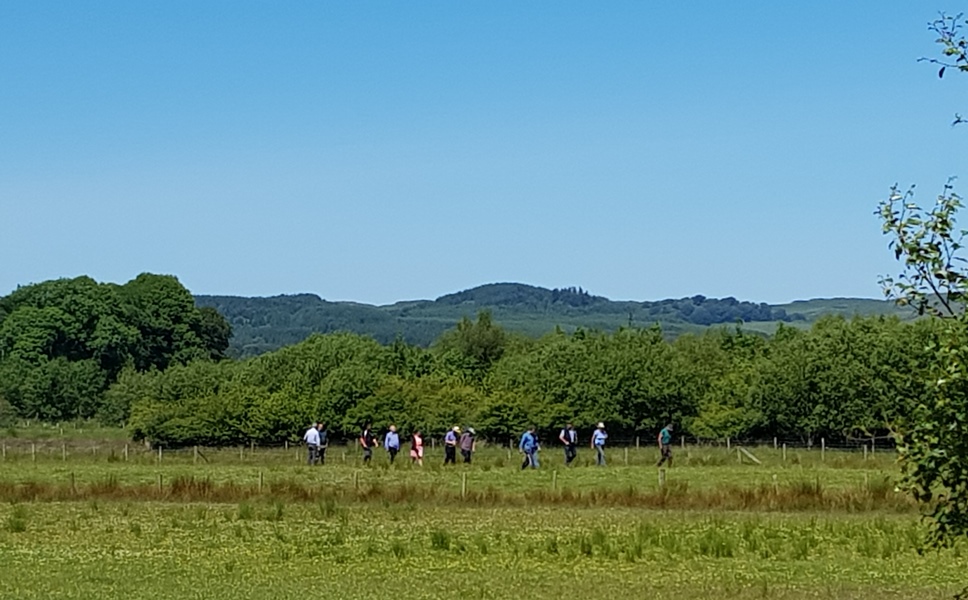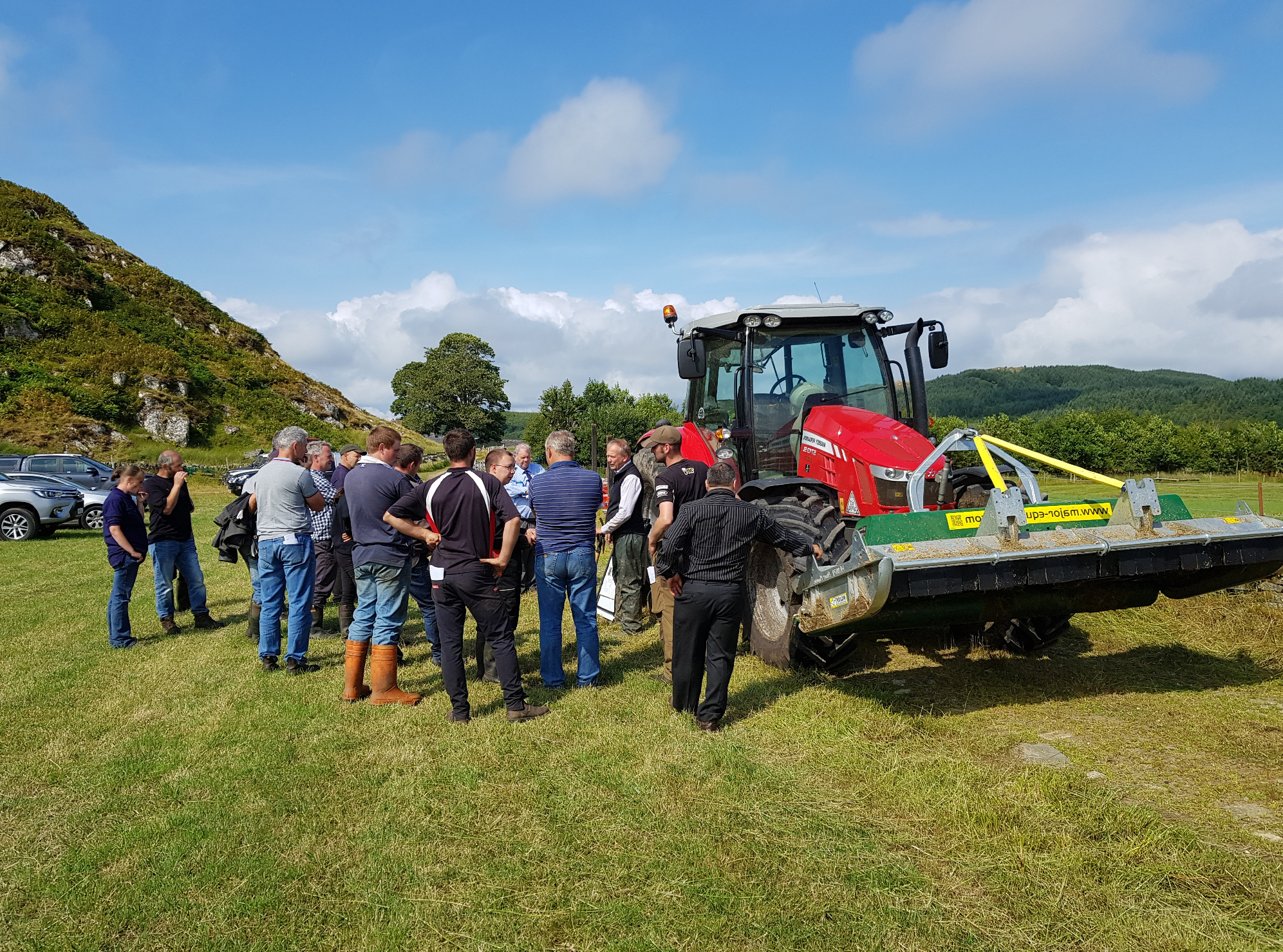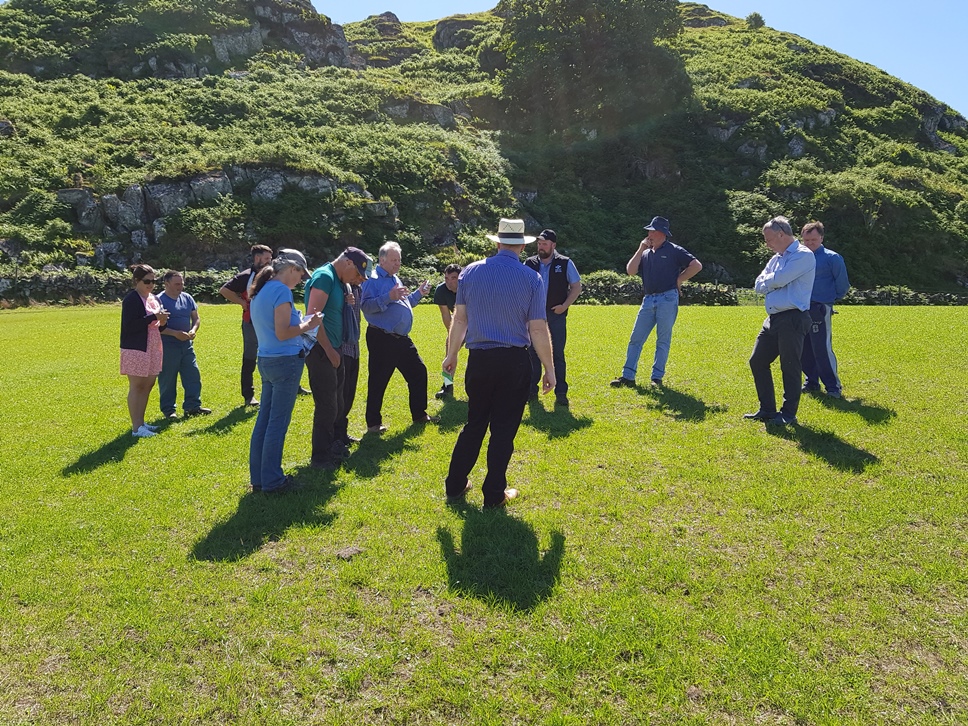Campbeltown Soil & Nutrient Network – Final meeting: event summary
28 June 2019“Making the Best Use of Your Grass and Forage Crops” was the theme for the final workshop for the Campbeltown Soil & Nutrient Network at the end of June 2019.
The aim of the workshop was to highlight the advantages of varying methods of reseeding pasture and to look at grass species in a mix that would withstand the grazing regime being adopted by the Foster family. Green crop was also debated, the various crops grown, the yield of dry matter and ultimately true cost.
The group moved out to a field destined for silage and grazing this year. It has been sprayed, drilled and limed during May. The discussions on site debated the openness of the grass cover and then general weed situation and how this can impact the quality and per formance of a grass sward. Some of those in attendance felt that ploughing, as opposed to direct drilling, may have given a better cover, and a different choice of seed mix and or application rate may also have proved more beneficial. In order to retrieve the sward, it was felt that over-seeding might be required to give the field the boost required to ensure it is productive. The farm walk moved on into a second field that had been flat-lifted and drilled later than the first. The grass covers were much better and highlighted how the effect of compaction can really impact on grassland productivity and ultimately the profitability of the field. The group conversations then turned to the grazing and grazing potential of the two swards by sheep and there was a lot of discussion about the viability of grass production for cutting in early 2020 if grazed.
formance of a grass sward. Some of those in attendance felt that ploughing, as opposed to direct drilling, may have given a better cover, and a different choice of seed mix and or application rate may also have proved more beneficial. In order to retrieve the sward, it was felt that over-seeding might be required to give the field the boost required to ensure it is productive. The farm walk moved on into a second field that had been flat-lifted and drilled later than the first. The grass covers were much better and highlighted how the effect of compaction can really impact on grassland productivity and ultimately the profitability of the field. The group conversations then turned to the grazing and grazing potential of the two swards by sheep and there was a lot of discussion about the viability of grass production for cutting in early 2020 if grazed.
The group revisited the topic of rush control to maintain quality pasture. Methods of control include weed wiping, and priority liming. Soil testing and drawing up a regular liming programme is essential for every farm and the value of this can not be underestimated.
Guest speakers John Holland & Ewen Campbell, from SRUC’s Hill & Mountain Research Centre at Kirkton, then explained about the work that they are involved with and the results of some of the research projects they are working on, including the methodology behind some of the reseed mixes chosen and how they are performing. They were keen to emphasise the shortness of seed durability and the need to manage persistent, older grass varieties.
Charles Murray from Clyde Agriculture, our other guest speaker. He gave an in-depth presentation about seed selection for grass leys; multi-species grazing crops; forage brassica crops and blends, and general establishment costs of production for any crops. The advice for multi-species winter grazing crops was to sow a wide range of species during peak grass production to produce a large volume of flowering and seeding plants for grazing with livestock during winter and early spring. Suggested crops included forage rye, kale, forage rape, turnip, birdsfoot trefoil, fodder radish and cereals. The benefits of such mixes include reduced wintering costs for livestock, a complete ration from grazing as well as improved soil structure, health and fertility from the variation in root types and the inclusion of legumes.
Charles’ advice for grass swards was to be clear about what you want from the investment and to give suitable consideration to the environmental conditions e.g. soil type, rainfall etc. He highlighted the range of species available to include in a sward mix, e.g. typical ryegrasses, clovers, fescues, cocksfoot and also the often overlooked, alternative species that can be considered, such as sheeps parsley, plantain, trefoil and sheeps burnet. You can read the brief summary of what to consider with each variety in the presentation slides which are available to download from here.
Take home messages
- Get soils in order for pH/P&K
- Carefully choose your method to prepare a field for reseeding
- Think about the after care of the sward by grazing
- Value the advise of a seed-man to help ensure you choose the correct mix for your farm
- Don’t try to “keep up with the Jones’s” – what works for one farm may not work for others, and the true cost must be considered.
Related News
Campbeltown Soil & Nutrient Network: 1st meeting – Event summary
The first meeting of the new Campbeltown Soil & Nutrient Network group was held at Dunadd Farm on a sunny 12th July. The event was kindly hosted by Roy Foster…
read more >- Valuing Your Soils – Practical Guidance for Scottish Farmers
- This brochure includes useful information about Scotland's agricultural soils and practical advice outlining the upfront financial savings and business benefits of better soil management and the efficient use of resources. Action and problem-specific 'field-sheets' are designed for busy farmers with limited time for reading.
- Topics: Climate Change, Soils, Water Management and Crops and Soils
- Control of Rushes TN701
- Topics: Crofts & Small Farms and Crops and Soils
- Healthy Grassland Soils – guide to soil assessment
- This is publication from Newcastle University, ADAS, SRUC & AHDB can be used to help you assess the health of your grassland soils
- Topics: Climate Change, Soils, Water Management and Crops and Soils
- Technical Note (TN719): Recommended Grass and Clover Varieties 2018-2019
- Technical Note (TN643): Weed Management in Grassland
- This technical note describes the most important weeds of grassland and their management. It is designed to be of value to low and high conventional input grassland systems, as well as potentially to organic systems.
- Topics: Crops and Soils
- Presentations slides used by Charles Murray, Clyde Agriculture (Seeds) Ltd during the final Campbeltown SNN event
- These are the presentation slides delivered by Charles Murray, Clyde Agriculture (Seeds) Ltd, during the final meeting of the Campbeltown Soil & Nutrient Network event held during June 2019
- Topics: Soils
- Soil & Nutrient Network: Case Study – Dunadd, Argyll
- The hosts for the Argyll Soil & Nutrient Network are C.R Foster & Partners. Whilst the home farm is Ashfield Achnamara, the partners have expanded their business by taking over the ownership of Dunadd this year. Find out more about the Argyll Soil & Nutrient Network in this Case Study.
- Topics: Soils
Sign up to the FAS newsletter
Receive updates on news, events and publications from Scotland’s Farm Advisory Service


